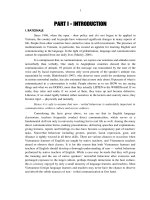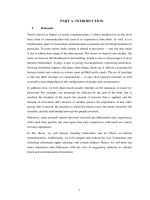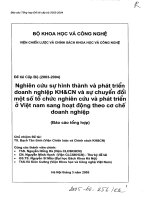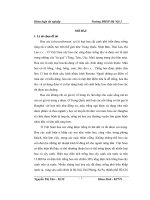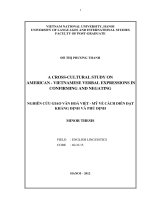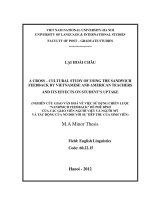a vietnamese - american cross-cultural study of encouraging = nghiên cứu giao văn hóa việt - mỹ về hành động khích lệ tt
Bạn đang xem bản rút gọn của tài liệu. Xem và tải ngay bản đầy đủ của tài liệu tại đây (135.49 KB, 5 trang )
VIETNAM NATIONAL UNIVERSITY, HANOI
UNIVERSITY OF LANGUAGES AND INTERNATIONAL STUDIES
FACULTY OF POSTGRADUATE STUDIES
LẠI THỊ THANH VÂN
A VIETNAMESE – AMERICAN
CROSS-CULTURAL STUDY OF ENCOURAGING
NGHIÊN CỨU GIAO VĂN HÓA VIỆT – MỸ
VỀ HÀNH ĐỘNG KHÍCH LỆ
MA COMBINED PROGRAMME THESIS
Field: English Linguistics
Code: 60.22.15
HANOI – 2010
VIETNAM NATIONAL UNIVERSITY, HANOI
UNIVERSITY OF LANGUAGES AND INTERNATIONAL STUDIES
FACULTY OF POSTGRADUATE STUDIES
LẠI THỊ THANH VÂN
A VIETNAMESE – AMERICAN
CROSS-CULTURAL STUDY OF ENCOURAGING
NGHIÊN CỨU GIAO VĂN HÓA VIỆT – MỸ
VỀ HÀNH ĐỘNG KHÍCH LỆ
MA COMBINED PROGRAMME THESIS
Field: English Linguistics
Code: 60.22.15
Supervisor: Prof. Nguyễn Quang, Ph.D.
HANOI – 2010
iv
TABLE OF CONTENTS
CERTIFICATE OF ORIGINALITY OF PROJECT REPORT i
ACKNOWLEDGEMENTS ii
ABSTRACT iii
TABLE OF CONTENTS iv
LIST OF ABBREVIATIONS AND CONVENTIONS vii
LIST OF TABLES viii
LIST OF FIGURES ix
INTRODUCTION 1
1. Rationale 1
2. Aims of the study 1
3. Scope of the study 2
4. Methods of the study 2
5. Organisation of the study 3
DEVELOPMENT 4
Chapter 1: LITERATURE REVIEW 4
1.1. Pragmatics and cross-cultural pragmatics 4
1.2. Speech acts 5
1.2.1. Definition of speech acts 5
1.2.2. Classifications of speech acts 7
1.2.3. Encouraging as a speech act 9
1.2.4. Encouraging and comforting 10
v
1.3. Politeness in Cross-cultural pragmatics 10
1.3.1. Politeness defined 10
1.3.2. Conversational-maxim view on politeness 12
1.3.3. Face-management view on politeness 13
1.3.4. Social variables affecting politeness 18
Chapter 2: METHODOLOGY 20
2.1. Research questions 20
2.2. Research design 20
2.2.1. Data collection instruments 20
2.2.2. Variables manipulated in data collection instruments 21
2.2.3. Contents of the questionnaires 22
2.2.4. Informants 24
2.2.5. Data collection procedure 24
2.3. Results of the MPQ 25
2.4. Realisation of politeness strategies in encouraging 29
Chapter 3: FINDINGS AND DISCUSSION 38
3.1. Overall number of strategies 38
3.2. Overall use of strategies 42
3.3. Use of strategies by social variables 44
3.4. Use of strategies by situations 48
3.4.1. Choice of encouraging strategies in high-power settings (+P) 50
3.4.2. Choice of encouraging strategies in equal-power settings (=P) 54
3.4.3. Choice of encouraging strategies in low-power settings (–P) 59
vi
CONCLUSION 65
1. Review of the main findings 65
2. Implications 68
3. Limitations 68
4. Suggestions for further study 69
REFERENCES 71
APPENDICES I
Appendix A: Metapragmatic Questionnaires (MPQ) I
Appendix B: Discourse Completion Task (DCT) XVII
Appendix C: Frequency Analysis for VNS and ANS XXI
Appendix D: Independent-Sampes t-Test Analysis for VNS and ANS XXV
